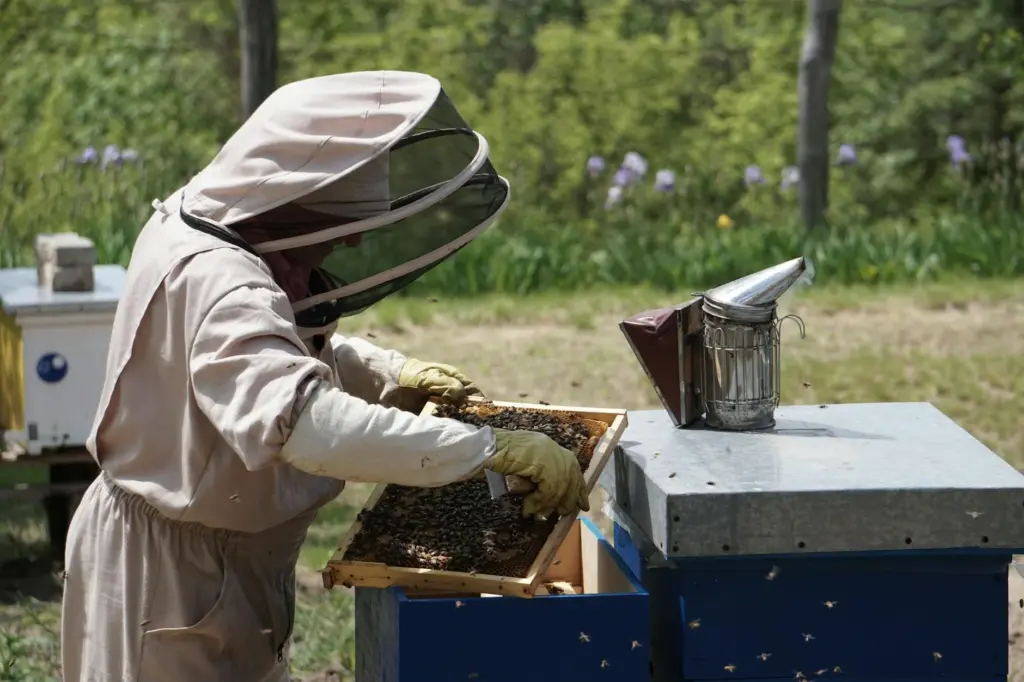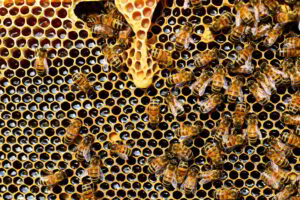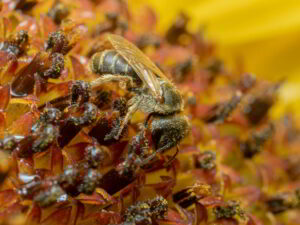Beekeeping Practices in Spring
Springtime is a critical period for beekeeping as bee activity ramps up with the blossoming of flowers. Beekeepers need to be vigilant and proactive in their practices to ensure a healthy and productive hive.
Monitoring Bee Foraging
In spring, bee foraging activity increases, and beekeepers should monitor this closely. Bees typically forage for a longer period than once believed, sometimes lasting up to six weeks. This extended foraging period implies that bees play a crucial role in pollination and honey production during this time. Maintaining a pollinator-friendly habitat is essential. Beekeepers should plant flowers that bloom at different times of the year and reserve sections for wildflowers and flowering weeds (Premier Bee Products).
| Spring Flowers | Foraging Period (Weeks) |
|---|---|
| Dandelions | 3 – 4 |
| Cherry Blossoms | 2 – 3 |
| Clover | 4 – 6 |
| Wildflowers | Varies |
Monitoring bee foraging is part of the broader practice of colony management in spring. This ensures bees have adequate forage and resources, critical for brood rearing and overall colony health. For more tips, explore our spring beekeeping tips.
Early Spring Varroa Management
Spring is the ideal time for Varroa mite management as bee and mite populations begin to grow. Early intervention is vital to prevent mite populations from spiraling out of control in the summer or fall (NOD Global).
Key practices include:
- Regular Monitoring: Frequently check for mite levels using methods such as sugar shakes or alcohol washes.
- Treatment Thresholds: Apply treatments when mite levels exceed specific thresholds to prevent overwhelming infestations.
- Selecting Resistant Stock: Introduce bee stocks known for their resistance to Varroa mites.
- Integrated Pest Management (IPM): Utilize a combination of mechanical, cultural, and chemical strategies to control mite populations.
| Mite Count | Recommended Action |
|---|---|
| 0 – 2 mites | Monitor and continue regular inspections |
| 3 – 6 mites | Consider mild intervention treatments |
| 7+ mites | Immediate and aggressive treatment required |
Managing Varroa mites effectively involves the use of accurate diagnostics and response plans tailored to specific treatment thresholds (Canadian Food Inspection Agency). For more detailed guidelines, check our spring beekeeping checklist.
Spring beekeeping practices also include ensuring that the colony has enough resources to feed the young bees and maintain the warmth of the hive (Penn State Extension). Early spring is a challenging period with fluctuating weather conditions and risks of illnesses such as Chalkbrood and Sacbrood appearing due to erratic floral resources.
For a comprehensive look at managing spring beekeeping activities, check out our section on spring beekeeping management.
Environmental Factors in Spring Beekeeping
Spring beekeeping involves a range of considerations, particularly taking into account the environmental factors that affect the health and productivity of bee colonies. Managing hives based on the specific conditions present during the spring season is crucial for successful beekeeping.
Colony Management Based on Conditions
Effective colony management in spring revolves around monitoring and responding to various environmental factors like temperature, colony buildup, and forage availability. Rather than adhering to a strict calendar, beekeepers should adapt their strategies to the actual circumstances their hives are facing (NOD Global).
Key points for colony management:
- Temperature Monitoring: Regular checks of outside temperatures can help determine if it’s safe to open hives for inspection.
- Colony Buildup: Assess the strength and size of bee colonies to decide if additional space or feeding is needed.
- Forage Availability: Identify the presence and abundance of flowering plants to ensure bees have adequate resources for foraging.
Spring inspections should also focus on checking for diseases and mites. As part of preventative measures, incorporating tools like the Ultimate Bottom Board from Bee Smart Designs can foster a robust and healthy hive foundation (ModernBeekeeper).
Strategies for Spring Beekeeping
Different strategies may be employed in spring beekeeping, depending on the goals and management style of the beekeeper. The following approaches are primarily recommended for spring:
- Biosecurity Measures: Implement measures to prevent the introduction and spread of diseases within the apiary.
- Integrated Pest Management (IPM): Use a combination of biological, physical, and chemical methods to control pests like the Varroa mite.
- Seasonal Needs: Address the changing needs of bees by ensuring proper nutrition, hive ventilation, and space.
Strategies can vary but typically include pre-treatment monitoring for mite infestations, as outlined by NOD Global. This can prevent potential issues before they escalate.
| Environmental Factor | Management Strategy |
|---|---|
| Temperature | Open hives only when temperatures are mild. |
| Colony Strength | Add frames or supers as needed. |
| Forage Availability | Ensure nearby plants are flowering. |
| Mite Infestation | Conduct pre-treatment mite checks. |
Utilizing modern tools and accessories like Anel Vapor Pads and EZ Grip Hive Handles can simplify various spring beekeeping activities, from inspections to smoke control.
For more detailed advice on spring beekeeping management, you can refer to our articles on spring beekeeping management and spring beekeeping tips.
By paying attention to these environmental factors and implementing the appropriate strategies, beekeepers can ensure their hives thrive during the busy spring season.
Essential Spring Beekeeping Equipment
Spring is a crucial time for beekeepers as they prepare their hives for increased activity. Having the right equipment is essential for ensuring a productive and healthy hive. Let’s explore the essential protective gear and modern tools needed for successful spring beekeeping practices.
Protective Gear and Supplies
Beekeeping requires both comfort and protection, especially during the busy spring season. Ensuring you have the proper gear can make all the difference.
- Beekeeping Suits:
- Ventilated Beekeeping Suit: Provides comfort and protection. Ideal for warm spring days.
- Children’s Beekeeping Suit: The ComfortPro Kid’s Round Veil Beekeeping Suit is perfect for young, aspiring beekeepers ModernBeekeeper.
- Beekeeping Jackets and Pants:
- Lightweight yet protective options to suit various weather conditions.
- Gloves:
- Essential for protecting hands during hive inspections.
- Veils and Hats:
- Keeps bees away from the face and head, ensuring safety and comfort.
For a complete list of essential gear, visit our spring beekeeping checklist.
Modern Tools for Beekeepers
Modern tools can simplify many beekeeping tasks, making the process more efficient and enjoyable. Here are some must-have tools for spring beekeeping:
- Electric Smokers:
- The Apisolis Electric Smoker and Vaporizer Pack offers a healthier and more efficient approach to smoke control ModernBeekeeper.
- Hive Tools:
- EZ Grip Hive Handle: Simplifies the process of lifting and inspecting hives.
- Anel Vapor Pads: Useful for maintaining optimal hive conditions.
- Hive Foundations:
- The Ultimate Bottom Board from Bee Smart Designs is critical for a healthy hive foundation, essential during spring preparations ModernBeekeeper.
- Monitoring and Inspection Tools:
- Tools like hive scrapers, frame grips, and inspection mirrors are vital for thorough hive inspections.
| Equipment Item | Features & Benefits |
|---|---|
| Ventilated Beekeeping Suit | Comfort and protection on warm days |
| ComfortPro Kid’s Round Veil Suit | Safety gear for young beekeepers |
| Apisolis Electric Smoker | Modern, healthier smoke control |
| EZ Grip Hive Handle | Easy hive lifting and inspections |
| Ultimate Bottom Board | Foundation for a healthy hive |
| Anel Vapor Pads | Maintenance of optimal hive conditions |
Equipping yourself with the right gear and tools sets the stage for successful spring beekeeping practices. For more in-depth tips and techniques, explore our article on spring beekeeping tips and spring beekeeping techniques.
Sustainable Practices for Bee Health
Spring is a critical time for beekeepers as they prepare their hives for the increased activity of the blooming season. Implementing sustainable practices ensures the health and productivity of bee colonies, setting the stage for a successful spring.
Impact of Nutrition on Bee Colonies
Good bee husbandry starts with providing bees access to adequate nutrition from pollen and nectar sources. Proper nutrition is essential for colony health and the immune response of bees to pathogens, especially viruses. Ensuring that bees forage on quality nutrition is paramount for their wellbeing (Scientific Beekeeping).
In early spring, feeding bees pollen is crucial for supplying them with necessary proteins, lipids, sterols, vitamins, minerals, and certain carbohydrates. This helps build a solid foundation for early spring flower blooms and promotes rapid population growth.
| Nutritional Component | Role in Bee Health |
|---|---|
| Protein | Essential for immune response and brood rearing |
| Lipids | Energy source and component of cell membranes |
| Sterols | Vital for hormone production and metabolism |
| Vitamins | Support metabolic processes and overall health |
| Minerals | Involved in various physiological functions |
| Carbohydrates | Primary energy source needed for daily activities |
Providing pollen patties and internal feeders ensures bees have the nutrition needed to start the season strong and support the growth of new brood. Adequate pollen availability is vital for rearing protein-rich “winter bees” that help the colony survive through the colder months.
Eco-Friendly Apiary Practices
Sustainable spring beekeeping also involves implementing eco-friendly practices that support the health of bee colonies and the environment. Providing bees with a warm, dry cavity for clustering and brood rearing is essential. Honey bees evolved in the tropics, and a warm environment aids their development. Ensuring bees have a sufficient honey store to generate heat for the colony is crucial. Keeping hives in full sun with exposure to morning sunlight minimizes issues such as varroa and tracheal mite infestations (Scientific Beekeeping).
Beekeepers should also consider:
- Placement of Hives: Position hives in areas with abundant flowers or supplement nutrition with sugar syrup and pollen substitutes if forage is poor. This sustains bee health and ensures they have resources needed for honey production.
- Minimizing Chemical Use: Avoid using harmful pesticides near hives. Instead, opt for natural pest control methods to protect bees and their environment.
- Supporting Biodiversity: Plant diverse, pollinator-friendly plants around the apiary to provide a consistent food source for bees throughout the season.
For more on managing hives based on environmental factors, check out our related articles on spring beekeeping management and spring beekeeping techniques.
Adopting sustainable practices in beekeeping not only ensures hive success during the spring but also contributes to the long-term health of bee populations and the larger ecosystem. For more tips and checklists, explore our detailed spring beekeeping checklist and guides.
Advanced Beekeeping Techniques
Spring is a time of increased activity for bees, and advanced beekeeping techniques can help ensure hive success during this busy season. Two key areas where innovation is making a significant impact are smart hive technology and data-driven beekeeping.
Smart Hive Technology
Smart hive technology enables beekeepers to monitor hive conditions in real-time, providing vital information on temperature, humidity, weight, and bee activity levels. This technology helps prevent issues like swarming, pests, and food shortages through timely interventions (Modern Beekeeper).
Using sensors and connected devices, beekeepers can receive alerts and detailed insights without the need for invasive inspections. This reduces stress on the bees and allows for better decision-making. For example, if the hive temperature drops, an alert can prompt the beekeeper to provide extra insulation or check for other issues.
| Smart Hive Feature | Benefits |
|---|---|
| Temperature Monitoring | Prevents overheating or chilling. |
| Humidity Control | Maintains optimal conditions. |
| Weight Measurement | Monitors honey production and food stores. |
| Activity Tracking | Detects swarming or health issues. |
For more tips on managing your hive during the spring, check out our spring beekeeping techniques page.
Data-Driven Beekeeping Approaches
Data-driven beekeeping involves the use of apps and software platforms to analyze hive behavior trends. By tracking honey production, predicting seasonal challenges, and refining approaches to feeding, pest control, and hive placement, beekeepers can make more informed decisions (Modern Beekeeper).
Digital logs allow beekeepers to record observations and compare data over time. This can be particularly useful in identifying patterns, such as the impact of weather changes on bee activity or the effectiveness of different pest control methods.
| Data Points | Uses |
|---|---|
| Honey Production Rates | Evaluates productivity and hive health. |
| Weather Patterns | Predicts seasonal impacts. |
| Pest Incidences | Tracks and adapts pest control strategies. |
| Feeding Logs | Optimizes feeding schedules and types. |
Leveraging these advanced techniques can transform your approach to beekeeping, making it more efficient and less intrusive on the bees. Be sure to consult our spring beekeeping checklist for more ways to get ready for the blooming season.
Community Engagement in Beekeeping
Benefits of Collaboration
Collaboration within the beekeeping community is indispensable, especially during the critical spring season. By working together, beekeepers can share knowledge, best practices, and innovations, fostering a supportive environment. Online forums, virtual workshops, and local beekeeping associations provide valuable opportunities to stay updated on advancements in the field.
Engaging with a network of fellow beekeepers can also help in solving common issues such as spring beekeeping management, ensuring that colonies are well-prepared for the busy season ahead. By sharing experiences and strategies, beekeepers can collectively improve the health and productivity of their hives. For more insights, check out our spring beekeeping tips.
Learning and Sharing Resources
Resource sharing is another critical aspect of community engagement in beekeeping. Beekeepers can exchange information on effective feeding practices, disease management, and innovative equipment. For example, feeding bees pollen in spring is crucial for providing essential nutrients that promote rapid population growth and prepare the hive for early spring blooms (Galena Farms).
Additionally, beekeepers in cooler climates must remain vigilant to ensure their colonies have adequate resources to maintain warmth and feed the young bees. Regular monitoring in early spring is essential to prevent starvation and manage the risk of brood diseases such as Chalkbrood, Sacbrood, and European Foulbrood (Penn State Extension).
Sharing resources and collaborating on research can also aid in addressing broader issues affecting honey bees, such as parasites, poor nutrition, and exposure to pesticides. Honey bees contribute at least $18 billion to the value of U.S. agriculture annually through pollination, but they are under pressure from multiple threats (USDA-ARS). By pooling resources and knowledge, the beekeeping community can work towards sustainable solutions to these challenges.
For a comprehensive list of actions to take, visit our spring beekeeping checklist and explore effective spring beekeeping techniques to maximize hive success.




